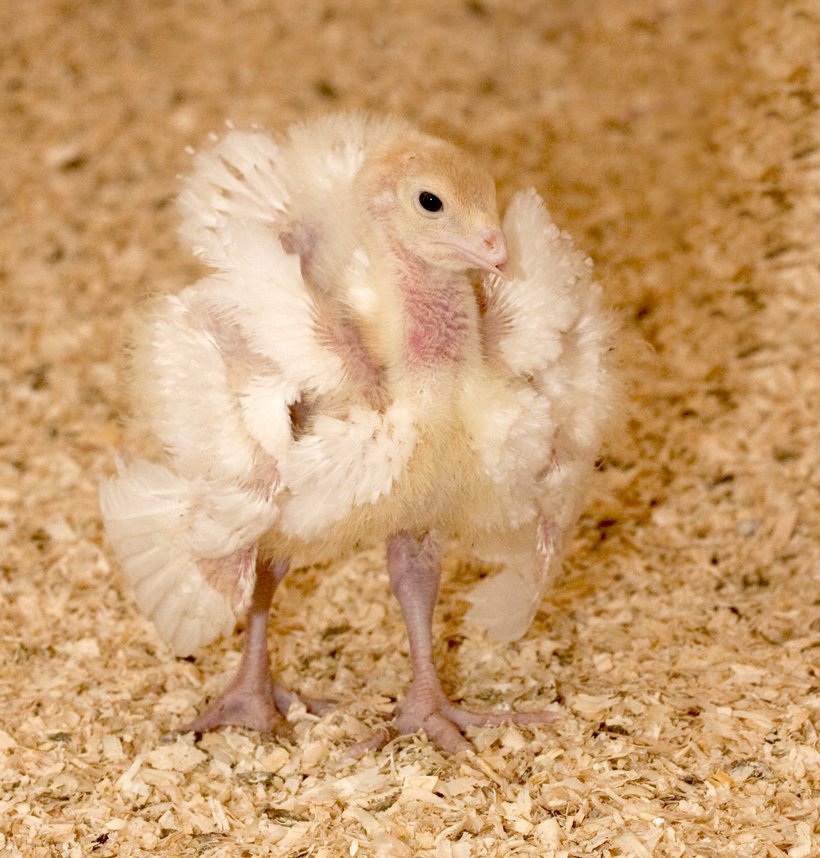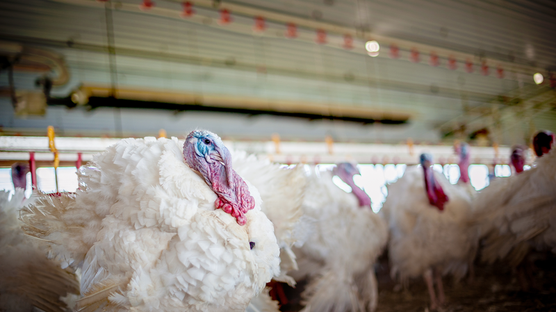
Published on May 10, 2017
Small but mighty: Caring for your poults to unlock their potential
Watching a flock of poults in the first days of life strutting around the barn, chirping, and eating well is one the best sights for a turkey producer. Not only because these little birds are cute and curious, but also because you know that keeping them happy and healthy, will have a lasting impact on their development throughout life.
Much like a new baby, poults need extra special care during the first few days of life. For example, a new parent will go to great lengths to protect their baby against germs, ensure they have enough to eat, and maintain a comfortable body temperature all to make sure they are at ease. These same elements can apply to your poults.
When preparing for your next poult delivery, and during the first stages of brooding, what do you do to make sure each area of focus is well managed and how do you ensure your poults are set up for success? There are some general checkpoints that producers around the world find useful and they can be broken into two areas: before poult delivery and after placement.
Before Poult Delivery – Proactive preparation
- Adequate downtime between flocks to minimize or eliminate potential pathogens is essential
21 days of downtime is recommended, with 7 of the 21 days as empty rest. This rest time should occur after cleaning and before you begin setup for the new flock.
- Clean the water lines
You may ask yourself, “why is on-farm water sanitation needed if the water is safe and healthy for me to drink?” The area of concern is not always the source of water, but the lines transporting the water through the farm. Microbial growth, known as biofilm, is created by buildup of naturally occurring iron, manganese, and sulfur as well as probiotics, citric acid, vitamins, organic acid, vaccines and milk replacer. This is why it is important to start the flock with clean water lines and continue with a consistent water sanitation program to control undesirable microbial growth.
- Pre-warm the brooder house
Like a baby, a poult is not able to regulate their own body temperature. To ensure that your poults are warm enough after being transitioned to the barn, it is suggested to allow 24-48 hours for pre-warming of the brooder house. In times of extreme cold, 72 hours is preferred.
- Correctly lay out heaters, feeders and drinkers
It is imperative that you place enough equipment to supply feed and water to your poults, based on the quantity of birds you will place. These should be evenly spaced throughout the brooding area. When setting up the heaters the goal is to ensure you will provide even distribution of temperature across the feed and water space as this is where you want your poults to congregate.
These essential checkpoints and more can be found here on the Hybrid Resources website.
After Poult Delivery – Ongoing care to ensure the comfort and health of your birds
- Monitor environmental conditions
Humidity and gases must be monitored regularly to ensure optimal poult comfort. One of the best ways to ensure great air quality is to condition the outside air as it comes into the barn.
Carbon Dioxide and Carbon Monoxide are also important to measure to ensure the health of yourself and your poults. A healthy environment has CO2 levels below 2,500 ppm and CO levels below 25 ppm.
- Watch and listen to what your birds are telling you
Finally, the behaviour of your poults is the best indication of their comfort. There are direct and indirect ways to evaluate this. Indirect evaluations include; monitoring feed consumption, activity, and noise level of the poults. If your poults are evenly distributed around the barn, moving frequently, and accessing feed and water, this is a good indication they are happy and comfortable in their surroundings. If you prefer a more direct system of monitoring comfort, you can measure a poult’s internal body temperature via a vent thermometer. We recommend a vent temperature range that falls between 103⁰F and 104⁰F (39.4⁰C and 40.0⁰C) in the first days of life.
Keeping your poults comfortable can feel like an intricate balancing act. It’s hard work and each flock is slightly different; however when you see and hear happy thriving poults, you can take pride in knowing you have done a great job and have set a great foundation for long-term flock performance.
To learn more about my recommendations, download my whitepaper on Factors contributing to consistent quality poult starts or visit the Hybrid Turkeys resources at www.resources.hybridturkeys.com/brooding-whole-room.



